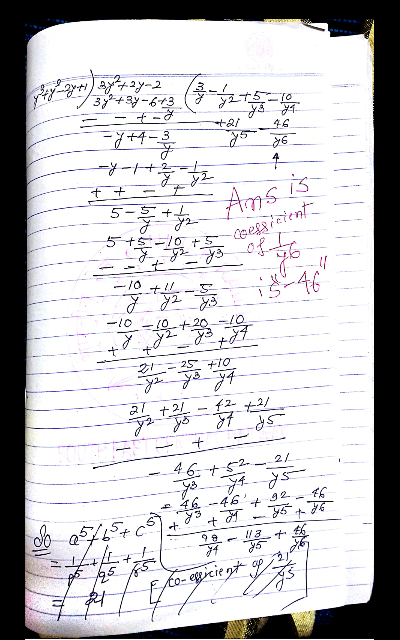
Question Number 46042 by naka3546 last updated on 20/Oct/18
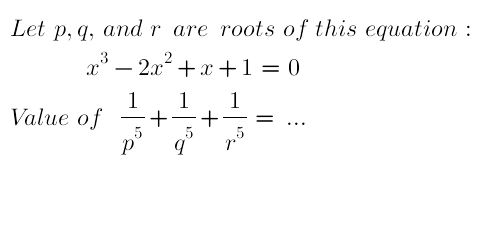
Commented by Tawa1 last updated on 20/Oct/18

$$\mathrm{Sir},\:\mathrm{can}\:\mathrm{you}\:\mathrm{share}\:\mathrm{me}\:\mathrm{the}\:\mathrm{link}\:\mathrm{to}\:\mathrm{download}\:\mathrm{this}\:\mathrm{pdf}\:\mathrm{or}\:\mathrm{how}\:\mathrm{can}\:\mathrm{i}\:\mathrm{get}\:\mathrm{it}\:\mathrm{sir} \\ $$
Commented by Kunal12588 last updated on 20/Oct/18

$${needs}\:{imaginary}\:{numbers}\: \\ $$$${real}\:{not}\:{working} \\ $$
Commented by tanmay.chaudhury50@gmail.com last updated on 20/Oct/18

$${i}\:{have}\:{checked}\:{Hall}\:{and}\:{knight}\:{higher}\:{algebra} \\ $$$${and}\:{Bernard}\:{and}\:{child}\:...{found}\:{some}\:{theorem} \\ $$$${i}\:{have}\:{solved}\:{the}\:{problem}\:{tsking}\:{help}... \\ $$
Commented by tanmay.chaudhury50@gmail.com last updated on 20/Oct/18
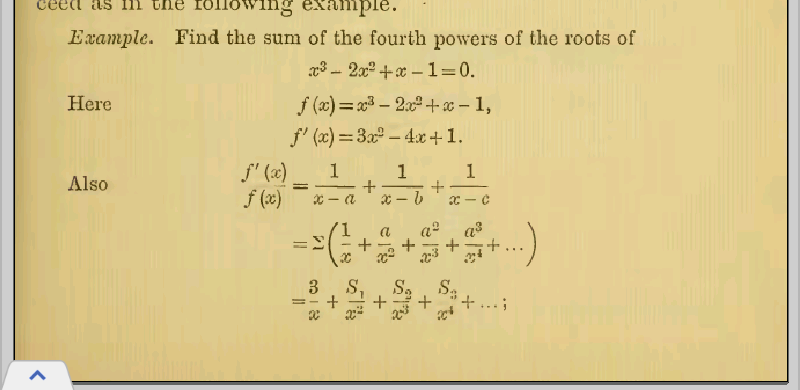
Commented by tanmay.chaudhury50@gmail.com last updated on 20/Oct/18
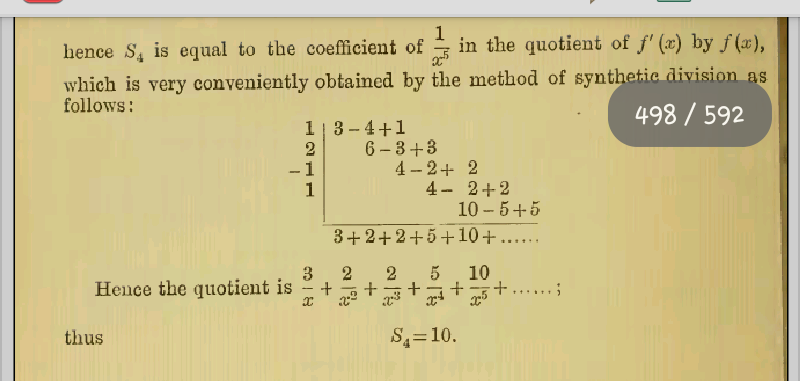
Commented by tanmay.chaudhury50@gmail.com last updated on 20/Oct/18
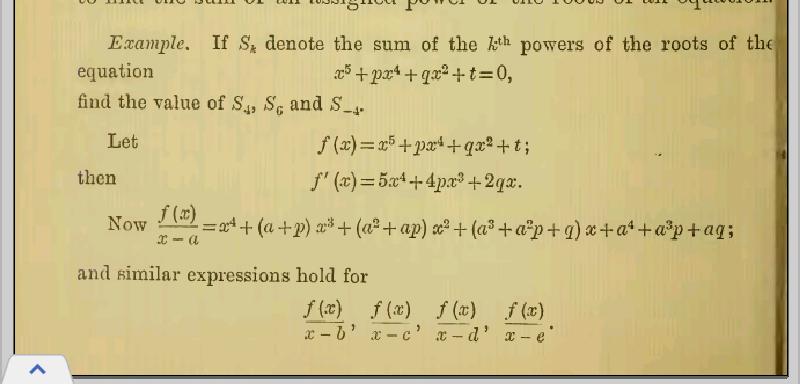
Commented by tanmay.chaudhury50@gmail.com last updated on 20/Oct/18
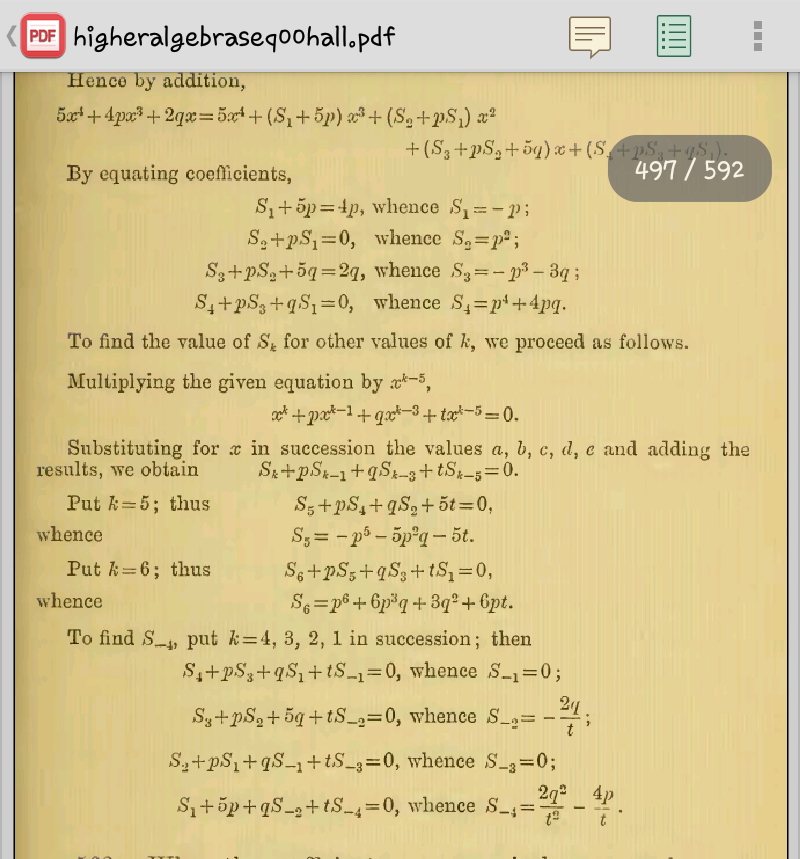
Commented by tanmay.chaudhury50@gmail.com last updated on 20/Oct/18
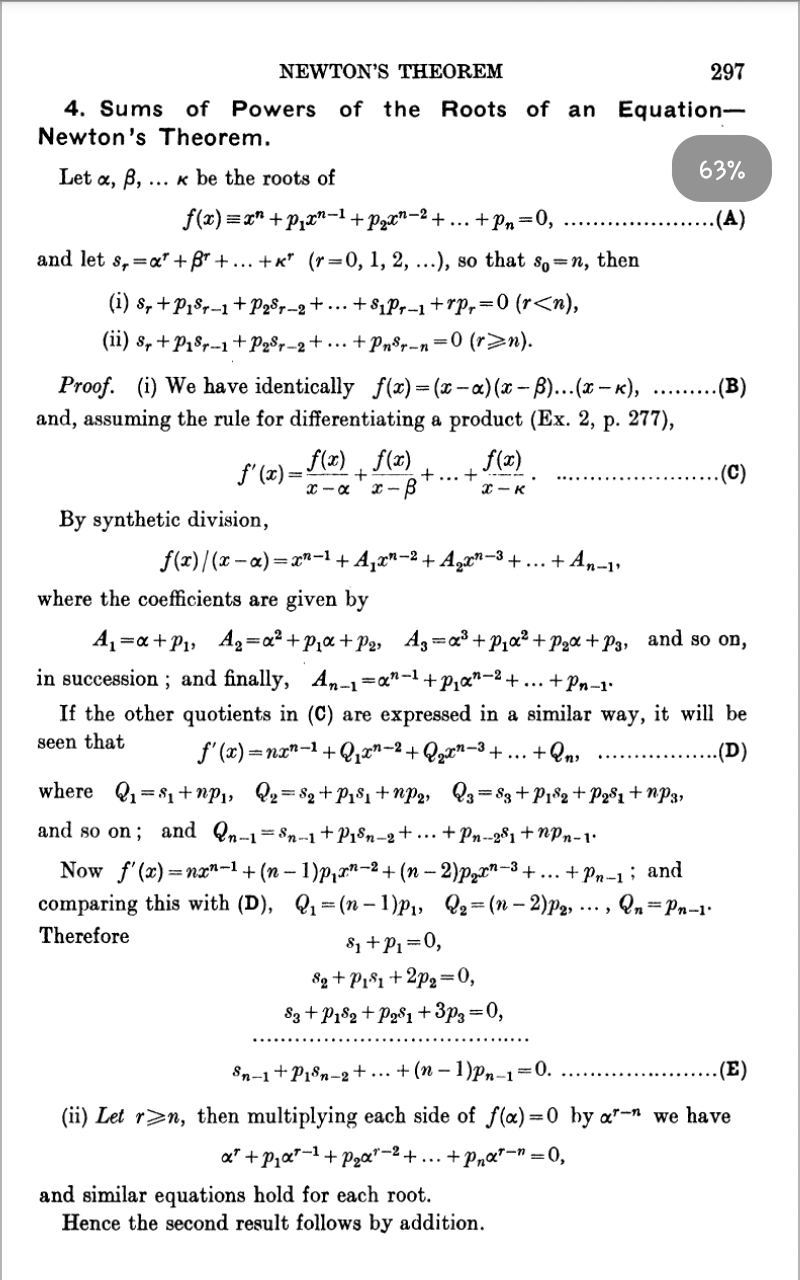
Commented by tanmay.chaudhury50@gmail.com last updated on 20/Oct/18

Commented by Tawa1 last updated on 20/Oct/18

$$\mathrm{God}\:\mathrm{bless}\:\mathrm{you}\:\mathrm{sir} \\ $$
Answered by MJS last updated on 20/Oct/18
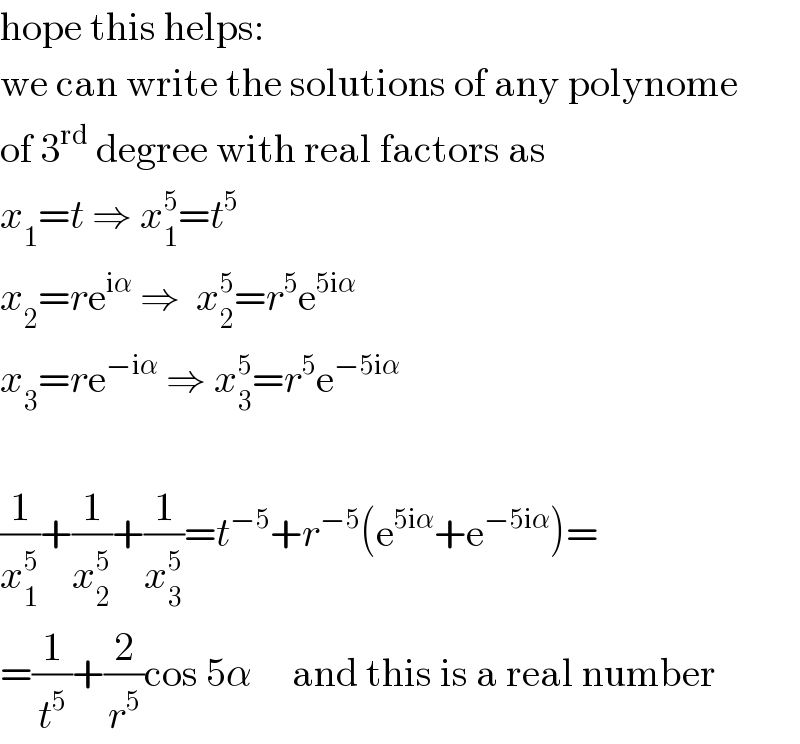
$$\mathrm{hope}\:\mathrm{this}\:\mathrm{helps}: \\ $$$$\mathrm{we}\:\mathrm{can}\:\mathrm{write}\:\mathrm{the}\:\mathrm{solutions}\:\mathrm{of}\:\mathrm{any}\:\mathrm{polynome} \\ $$$$\mathrm{of}\:\mathrm{3}^{\mathrm{rd}} \:\mathrm{degree}\:\mathrm{with}\:\mathrm{real}\:\mathrm{factors}\:\mathrm{as} \\ $$$${x}_{\mathrm{1}} ={t}\:\Rightarrow\:{x}_{\mathrm{1}} ^{\mathrm{5}} ={t}^{\mathrm{5}} \\ $$$${x}_{\mathrm{2}} ={r}\mathrm{e}^{\mathrm{i}\alpha} \:\Rightarrow\:\:{x}_{\mathrm{2}} ^{\mathrm{5}} ={r}^{\mathrm{5}} \mathrm{e}^{\mathrm{5i}\alpha} \\ $$$${x}_{\mathrm{3}} ={r}\mathrm{e}^{−\mathrm{i}\alpha} \:\Rightarrow\:{x}_{\mathrm{3}} ^{\mathrm{5}} ={r}^{\mathrm{5}} \mathrm{e}^{−\mathrm{5i}\alpha} \\ $$$$ \\ $$$$\frac{\mathrm{1}}{{x}_{\mathrm{1}} ^{\mathrm{5}} }+\frac{\mathrm{1}}{{x}_{\mathrm{2}} ^{\mathrm{5}} }+\frac{\mathrm{1}}{{x}_{\mathrm{3}} ^{\mathrm{5}} }={t}^{−\mathrm{5}} +{r}^{−\mathrm{5}} \left(\mathrm{e}^{\mathrm{5i}\alpha} +\mathrm{e}^{−\mathrm{5i}\alpha} \right)= \\ $$$$=\frac{\mathrm{1}}{{t}^{\mathrm{5}} }+\frac{\mathrm{2}}{{r}^{\mathrm{5}} }\mathrm{cos}\:\mathrm{5}\alpha\:\:\:\:\:\mathrm{and}\:\mathrm{this}\:\mathrm{is}\:\mathrm{a}\:\mathrm{real}\:\mathrm{number} \\ $$
Answered by ajfour last updated on 20/Oct/18
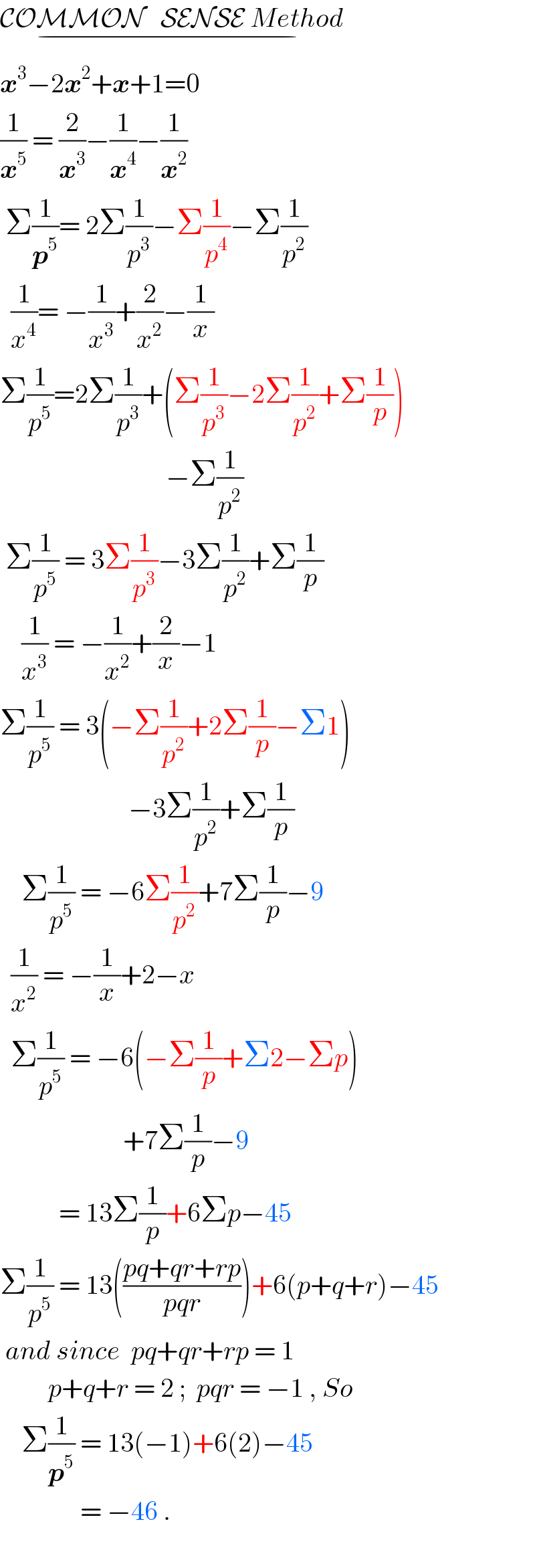
$$\underset{−} {\mathcal{COMMON}\:\:\:\mathcal{SENSE}\:{Method}\:} \\ $$$$\boldsymbol{{x}}^{\mathrm{3}} −\mathrm{2}\boldsymbol{{x}}^{\mathrm{2}} +\boldsymbol{{x}}+\mathrm{1}=\mathrm{0} \\ $$$$\frac{\mathrm{1}}{\boldsymbol{{x}}^{\mathrm{5}} }\:=\:\frac{\mathrm{2}}{\boldsymbol{{x}}^{\mathrm{3}} }−\frac{\mathrm{1}}{\boldsymbol{{x}}^{\mathrm{4}} }−\frac{\mathrm{1}}{\boldsymbol{{x}}^{\mathrm{2}} } \\ $$$$\:\Sigma\frac{\mathrm{1}}{\boldsymbol{{p}}^{\mathrm{5}} }=\:\mathrm{2}\Sigma\frac{\mathrm{1}}{{p}^{\mathrm{3}} }−\Sigma\frac{\mathrm{1}}{{p}^{\mathrm{4}} }−\Sigma\frac{\mathrm{1}}{{p}^{\mathrm{2}} } \\ $$$$\:\:\frac{\mathrm{1}}{{x}^{\mathrm{4}} }=\:−\frac{\mathrm{1}}{{x}^{\mathrm{3}} }+\frac{\mathrm{2}}{{x}^{\mathrm{2}} }−\frac{\mathrm{1}}{{x}} \\ $$$$\Sigma\frac{\mathrm{1}}{{p}^{\mathrm{5}} }=\mathrm{2}\Sigma\frac{\mathrm{1}}{{p}^{\mathrm{3}} }+\left(\Sigma\frac{\mathrm{1}}{{p}^{\mathrm{3}} }−\mathrm{2}\Sigma\frac{\mathrm{1}}{{p}^{\mathrm{2}} }+\Sigma\frac{\mathrm{1}}{{p}}\right) \\ $$$$\:\:\:\:\:\:\:\:\:\:\:\:\:\:\:\:\:\:\:\:\:\:\:\:\:\:\:\:\:\:\:−\Sigma\frac{\mathrm{1}}{{p}^{\mathrm{2}} } \\ $$$$\:\Sigma\frac{\mathrm{1}}{{p}^{\mathrm{5}} }\:=\:\mathrm{3}\Sigma\frac{\mathrm{1}}{{p}^{\mathrm{3}} }−\mathrm{3}\Sigma\frac{\mathrm{1}}{{p}^{\mathrm{2}} }+\Sigma\frac{\mathrm{1}}{{p}} \\ $$$$\:\:\:\:\frac{\mathrm{1}}{{x}^{\mathrm{3}} }\:=\:−\frac{\mathrm{1}}{{x}^{\mathrm{2}} }+\frac{\mathrm{2}}{{x}}−\mathrm{1} \\ $$$$\Sigma\frac{\mathrm{1}}{{p}^{\mathrm{5}} }\:=\:\mathrm{3}\left(−\Sigma\frac{\mathrm{1}}{{p}^{\mathrm{2}} }+\mathrm{2}\Sigma\frac{\mathrm{1}}{{p}}−\Sigma\mathrm{1}\right) \\ $$$$\:\:\:\:\:\:\:\:\:\:\:\:\:\:\:\:\:\:\:\:\:\:\:\:−\mathrm{3}\Sigma\frac{\mathrm{1}}{{p}^{\mathrm{2}} }+\Sigma\frac{\mathrm{1}}{{p}} \\ $$$$\:\:\:\:\Sigma\frac{\mathrm{1}}{{p}^{\mathrm{5}} }\:=\:−\mathrm{6}\Sigma\frac{\mathrm{1}}{{p}^{\mathrm{2}} }+\mathrm{7}\Sigma\frac{\mathrm{1}}{{p}}−\mathrm{9} \\ $$$$\:\:\frac{\mathrm{1}}{{x}^{\mathrm{2}} }\:=\:−\frac{\mathrm{1}}{{x}}+\mathrm{2}−{x} \\ $$$$\:\:\Sigma\frac{\mathrm{1}}{{p}^{\mathrm{5}} }\:=\:−\mathrm{6}\left(−\Sigma\frac{\mathrm{1}}{{p}}+\Sigma\mathrm{2}−\Sigma{p}\right) \\ $$$$\:\:\:\:\:\:\:\:\:\:\:\:\:\:\:\:\:\:\:\:\:\:\:+\mathrm{7}\Sigma\frac{\mathrm{1}}{{p}}−\mathrm{9} \\ $$$$\:\:\:\:\:\:\:\:\:\:\:=\:\mathrm{13}\Sigma\frac{\mathrm{1}}{{p}}+\mathrm{6}\Sigma{p}−\mathrm{45} \\ $$$$\Sigma\frac{\mathrm{1}}{{p}^{\mathrm{5}} }\:=\:\mathrm{13}\left(\frac{{pq}+{qr}+{rp}}{{pqr}}\right)+\mathrm{6}\left({p}+{q}+{r}\right)−\mathrm{45} \\ $$$$\:{and}\:{since}\:\:{pq}+{qr}+{rp}\:=\:\mathrm{1} \\ $$$$\:\:\:\:\:\:\:\:\:{p}+{q}+{r}\:=\:\mathrm{2}\:;\:\:{pqr}\:=\:−\mathrm{1}\:,\:{So} \\ $$$$\:\:\:\:\Sigma\frac{\mathrm{1}}{\boldsymbol{{p}}^{\mathrm{5}} }\:=\:\mathrm{13}\left(−\mathrm{1}\right)+\mathrm{6}\left(\mathrm{2}\right)−\mathrm{45} \\ $$$$\:\:\:\:\:\:\:\:\:\:\:\:\:\:\:=\:−\mathrm{46}\:. \\ $$$$ \\ $$
Commented by naka3546 last updated on 20/Oct/18

$$−\mathrm{46} \\ $$
Commented by ajfour last updated on 20/Oct/18

$${yes},\:{i}\:{corrected}! \\ $$
Answered by naka3546 last updated on 20/Oct/18
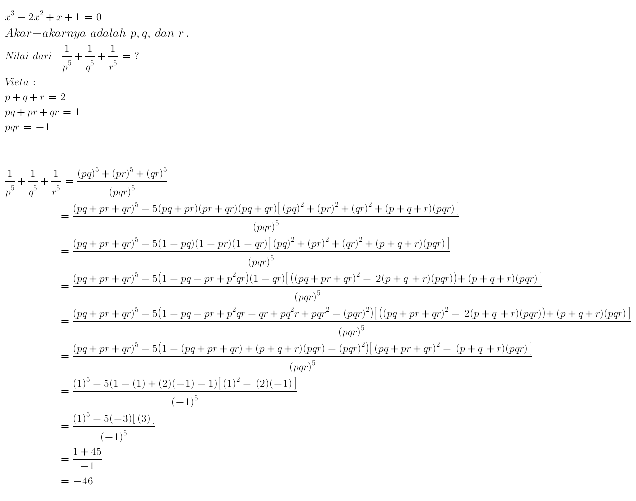
Commented by Tawa1 last updated on 20/Oct/18

$$\mathrm{The}\:\mathrm{image}\:\mathrm{is}\:\mathrm{not}\:\mathrm{clear}\:\mathrm{sir} \\ $$
Answered by tanmay.chaudhury50@gmail.com last updated on 20/Oct/18
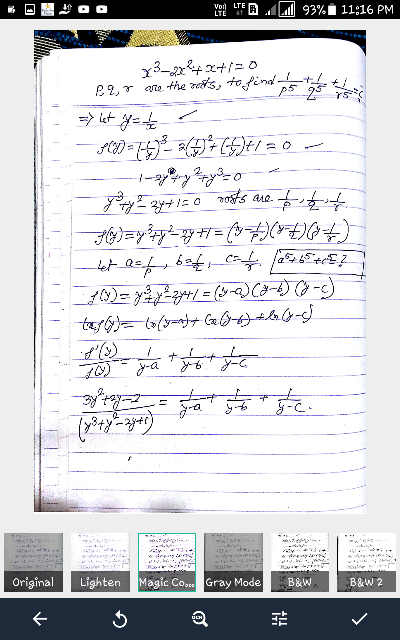
Commented by tanmay.chaudhury50@gmail.com last updated on 20/Oct/18
